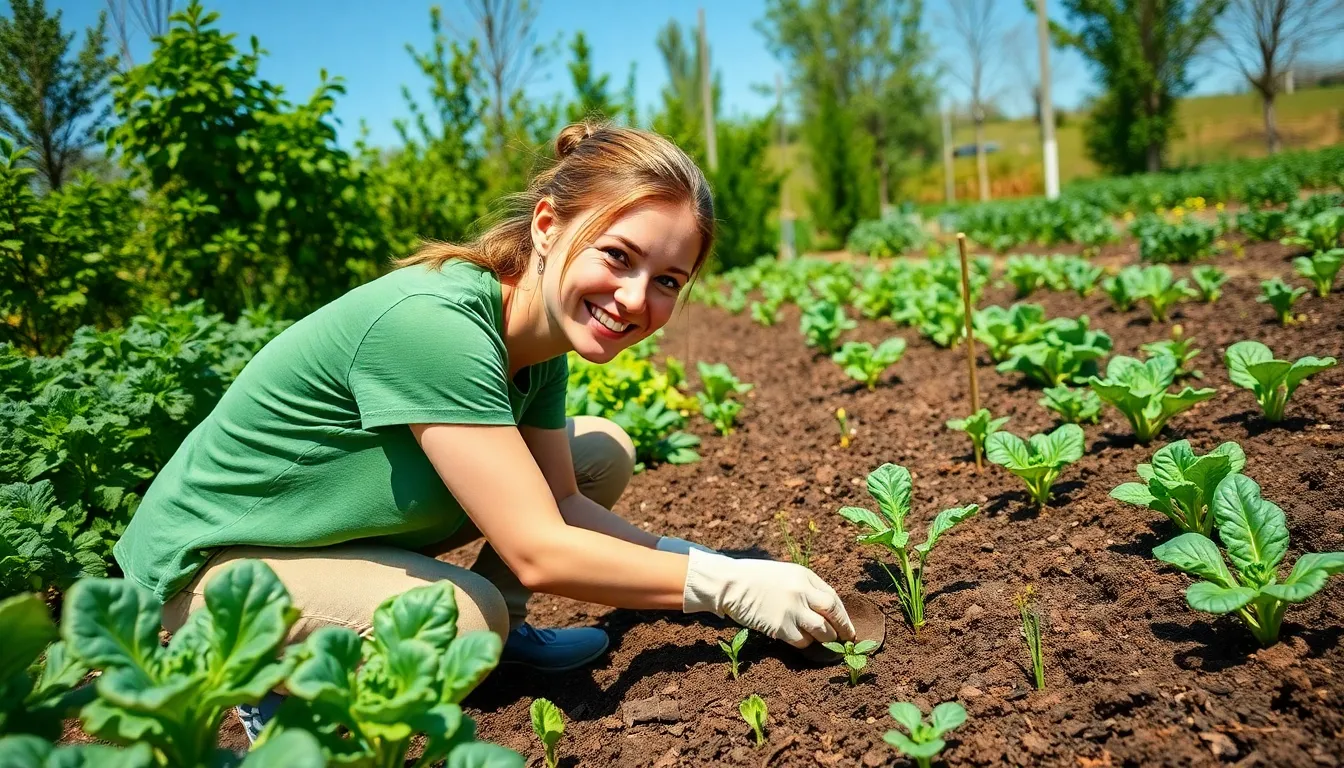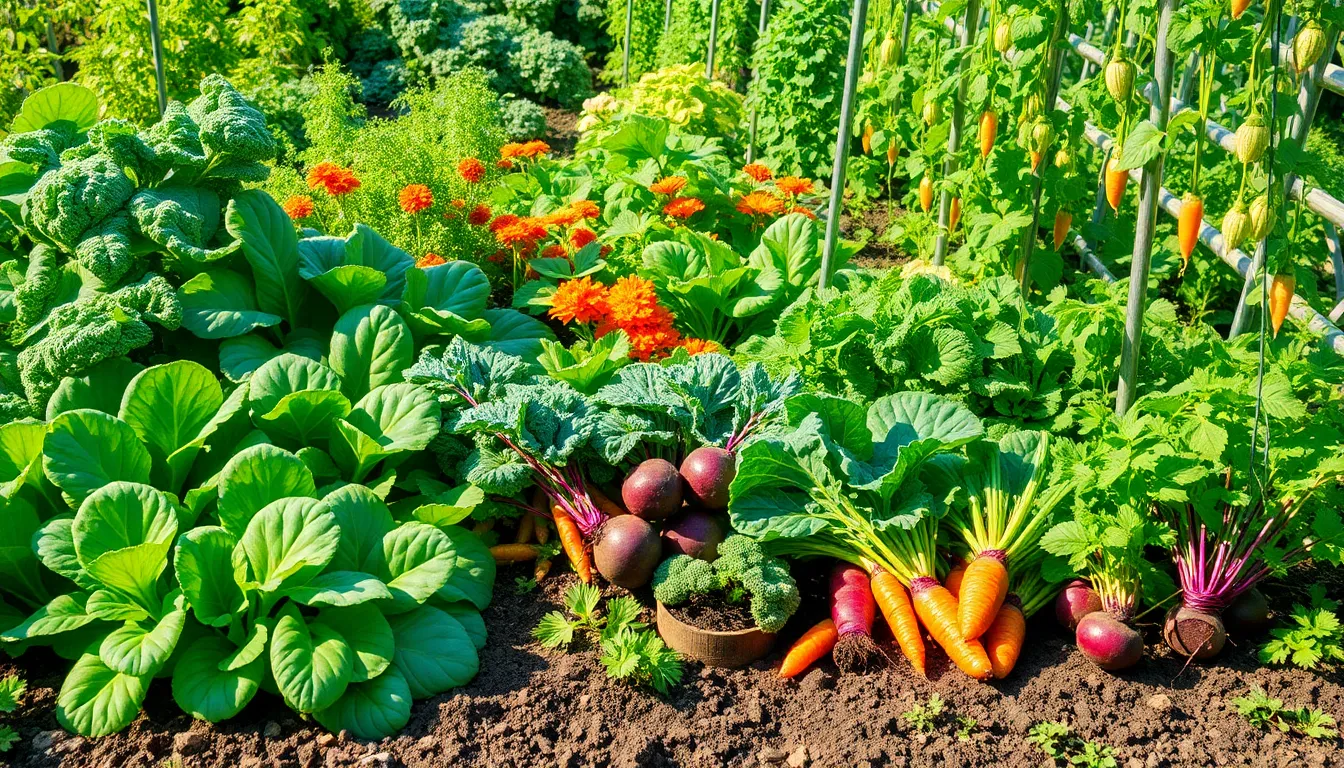Physical Address
304 North Cardinal St.
Dorchester Center, MA 02124

As winter waves goodbye and spring bursts onto the scene, it’s time to shake off the frost and get those gardening gloves ready. Planting spring vegetables is like giving your taste buds a fresh start after a long hibernation. Imagine biting into a crisp, homegrown carrot or tossing a handful of vibrant greens into your salad. Who knew dirt could be so delicious?
Planting spring vegetables offers numerous advantages for gardeners. Fresh nutrients play a crucial role in spring growth. Many spring vegetables, such as spinach and radishes, thrive in cooler temperatures, which encourages early harvests. Increased sunlight during spring promotes rapid plant growth, resulting in flavorful produce.
Heirloom varieties provide unique tastes and colors, enhancing a garden’s diversity. Homegrown vegetables significantly reduce grocery costs while ensuring access to organic produce. Engaging in gardening improves mental well-being, as the act of nurturing plants fosters relaxation and satisfaction.
Providing habitats for beneficial insects occurs when gardeners cultivate diverse crops. Vegetables attract pollinators that support overall garden health. Spring gardens can also contribute to soil enrichment, as many vegetables add nutrients back into the ground.
Regular harvesting encourages continual growth, leading to bountiful yields throughout the season. Many gardeners enjoy the satisfaction of witnessing their efforts transform into delicious meals. Incorporating spring vegetables can inspire healthy eating habits, making it easier to incorporate fresh produce into daily diets.
Seasonal planting enables gardeners to create crop rotation schedules. Crop rotation helps prevent soil depletion and diseases, promoting sustainable gardening practices. Sustainability and local food production benefit significantly from planting spring vegetables, which reduce reliance on imported produce.
The benefits of planting spring vegetables include nutritional health, cost savings, mental well-being, and environmental sustainability. Each benefit enhances the experience of gardening, making it a rewarding springtime activity.

Spring’s arrival brings the perfect opportunity to plant a variety of vegetables. Engaging with these crops not only enhances gardens but also supports healthy diets.
Leafy greens flourish in the cool spring temperatures. Spinach, kale, and lettuce produce tender leaves packed with nutrients. They thrive when planted early, with some varieties ready for harvest in just 30 days. Ideal for succession planting, these crops allow for continuous yields. Regular watering helps maintain their crisp texture and vibrant colors. Growing different types of greens offers diverse flavors and textures, enhancing salads and dishes alike.
Root vegetables like carrots, radishes and beets take advantage of spring soil. Starting them early ensures tasty harvests by summer. Each vegetable serves a unique purpose in culinary creations, providing essential vitamins and minerals. Carrots develop sweetness with cooler weather, while radishes grow quickly and can be ready in about 25 days. Soil depth matters, as deeper cultivation yields larger, healthier roots. They also store well, allowing for enjoyment long after the harvest.
Peas and beans thrive during the transition from winter to spring. Planting varieties such as sugar snap peas and bush beans promotes rapid growth. Peas typically mature within 60 days, creating a sweet, crisp snack. Beans, on the other hand, add protein-rich options to meals. Both crops benefit from trellising, providing support as they climb. In addition, planting them early helps gardeners enjoy a bountiful harvest. These legumes improve soil health through nitrogen fixation, enhancing garden sustainability.
Proper planting techniques enhance the success of spring vegetable gardens. Effective strategies involve preparing soil and timing sowing for optimal growth.
Healthy soil boosts vegetable growth. Start by clearing debris and rocks from the garden bed. Adding organic matter, such as compost, enriches the soil with essential nutrients. Test soil pH to ensure it falls between 6.0 and 7.0 for ideal vegetable health. Tilling the soil allows air circulation and improves drainage. Mix in fertilizers as needed, giving roots access to necessary elements. Such preparations lay a strong foundation for germination and continued growth.
Timing is crucial for spring planting. Average last frost dates typically fall between late March and early May in many regions. Planting seeds too early can expose them to frost damage. Aim for sowing seeds once soil temperatures reach at least 50°F to ensure germination. Transplanting seedlings indoors a few weeks earlier reduces the risk of frost loss. Regularly check weather forecasts for unexpected drops in temperature. Calculating planting dates based on local climate conditions promotes healthy vegetable development.
Pests and diseases can disrupt spring vegetable gardens. Aphids, small sap-sucking insects, often infest tender leaves, leading to stunted growth. Another common pest is the cucumber beetle, which damages young plants and can spread bacterial wilt. Control methods include introducing beneficial insects like ladybugs and using insecticidal soap.
Fungal diseases, such as powdery mildew, frequently affect leafy greens. High humidity and poor air circulation can exacerbate these issues. To combat mildew, it’s helpful to plant resistant varieties and ensure proper spacing between plants to promote airflow.
Root rot, caused by excess moisture and poor drainage, presents another threat. Early signs include yellowing leaves and wilting plants. Improving soil drainage through raised beds can help prevent root rot.
In addition to these challenges, garden pests sometimes include slugs and snails. They typically feed on tender leaves at night, leaving behind irregular holes. Traps made from beer or copper wire can deter these pests effectively.
Furthermore, carrot flies target root vegetables like carrots and parsnips, resulting in tunneled roots. Floating row covers can be an effective protective measure during the active flight period.
Monitoring the garden regularly allows gardeners to identify and address issues promptly. Integrating pest management strategies, like companion planting, can reduce pest populations. Diverse plant selection attracts beneficial insects, which help control harmful pests naturally. Engaging with these practices promotes a healthier, more productive vegetable garden, enriching the overall gardening experience.
Planting spring vegetables offers a rewarding experience that goes beyond just growing food. The vibrant flavors and nutritional benefits of homegrown produce enhance meals and promote healthier eating habits. By embracing the joys of gardening, individuals foster a deeper connection with nature while also supporting local ecosystems.
As gardeners prepare for the season, they can look forward to the satisfaction of watching their crops flourish. With proper techniques and a little patience, the rewards of a bountiful harvest are well within reach. Engaging in this sustainable practice not only nurtures the body but also uplifts the spirit, making spring gardening a cherished tradition for many.